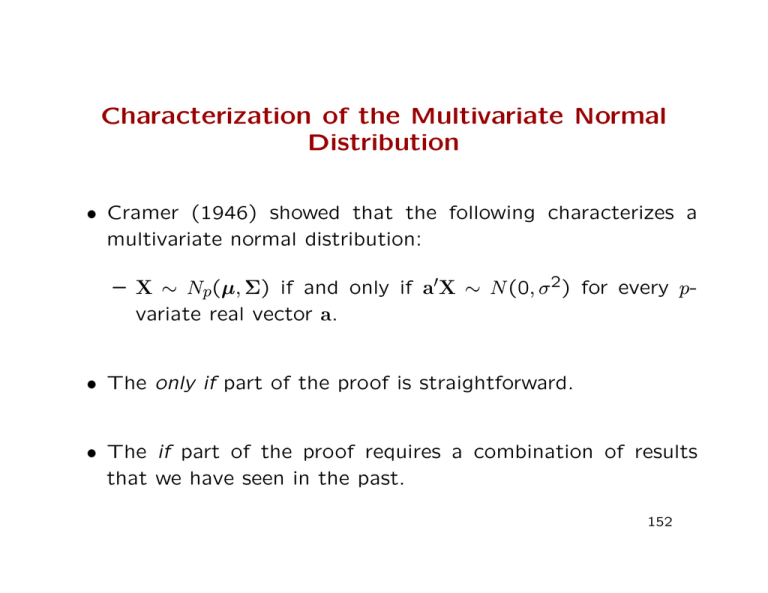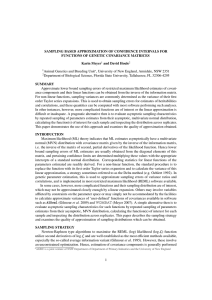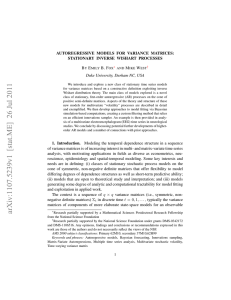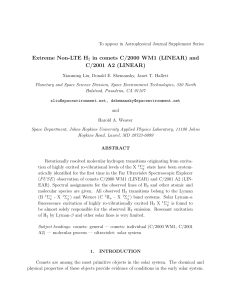Characterization of the Multivariate Normal Distribution
advertisement

Characterization of the Multivariate Normal Distribution • Cramer (1946) showed that the following characterizes a multivariate normal distribution: – X ∼ Np(µ, Σ) if and only if a0X ∼ N (0, σ 2) for every pvariate real vector a. • The only if part of the proof is straightforward. • The if part of the proof requires a combination of results that we have seen in the past. 152 ML Estimation of Parameters • Henceforth, we will work with a sample X1, X2..., Xn ∼ Np(µ, Σ). 1 • The MLEs for µ and Σ are given by µ̂p×1 = X̄ = n P 1 and Σ̂ = n i(Xi − X̄)(Xi − X̄)0 = (n−1) n S. Pn i=1 Xi – The derivation uses properties of p.d. matrices and: The identity matrix Ip is the sole among all p×p-dimensional positive definite matrices B that maximizes n n/2 f (B) = |nB| exp − trace(B) . 2 (1) – We could also use vector and matrix derivatives. 153 Sampling distribution of MLE’s • Suppose that X1, X2, ..., Xn ∼ Np(µ, Σ). Maximum likelihood 1 Pn estimates are µ̂p×1 = X̄ = n i=1 Xi and 1X (n − 1) Σ̂ = (Xi − X̄)(Xi − X̄)0 = S. n i n • X̄ and S are independent 1 Σ). • The sampling distribution of X̄ is Np(µ, n • (n − 1)S is distributed as a Wishart random matrix with n − 1 df and parameter Σ. 154 Sampling distribution of S • First consider the univariate case and recall that (n − 1)s2 = (xi − x̄)2 ∼ σ 2χ2 n−1 . X i • Since χ2 n−1 is also the distribution of the sum of n − 1 independent standard normal random variables, then 2 ) (n − 1)s2 ∼ σ 2(Z12 + ... + Zn−1 = (σZ1)2 + ... + (σZn−1)2. 155 Sampling distribution of S • Definition: The Wishart distribution with m degrees of freedom and parameter Σ, denoted by Wm(Σ), is the distribution of m X ZiZi0, i=1 where Zi ∼ Np(0, Σ) are independent random vectors. • If Ap×p is a positive definite random matrix and A ∼ Wn−1(Σ), the density function is wn−1(A|Σ) = |A|(n−p−2)/2 exp(−tr(AΣ−1)/2) Qp 2p(n−2)/2π p(p−1)/4|Σ|(n−1)/2 j=1 Γ(0.5(n − j)) where Γ(.) is the gamma function. 156 , Sampling distribution of S (cont’d) • If A1 ∼ Wm1 (Σ) is independent of A2 ∼ Wm2 (Σ), then A1 + A2 ∼ Wm1+m2 (Σ). • If A ∼ Wm(Σ), then CAC 0 ∼ Wm(CΣC 0). • If A ∼ Wm(Σ), then E(A) = mΣ. • Using results above it can be shown that (n − 1)S = (Xi − X̄)(Xi − X̄)0 ∼ Wn−1(Σ) X i with expectation (n − 1)Σ. 157











